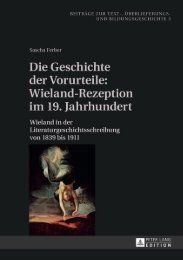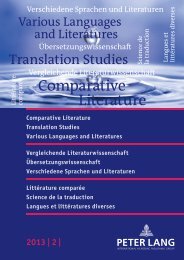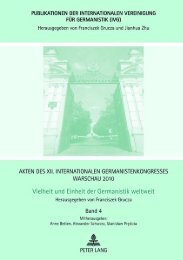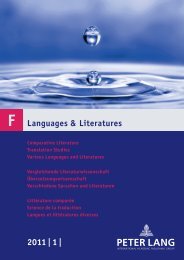Extract (PDF) - Peter Lang
Extract (PDF) - Peter Lang
Extract (PDF) - Peter Lang
Create successful ePaper yourself
Turn your PDF publications into a flip-book with our unique Google optimized e-Paper software.
20 Fernanda Peñaloza<br />
by ecologists. Not surprisingly, travel books on Patagonia nowadays are<br />
usually photographic, depicting Patagonia’s natural richness devoid of<br />
human presence.<br />
Hence, although Patagonia has been mapped, surveyed and explored<br />
for over 400 years, and the narratives that created its most perdurable myths<br />
are evidence of histories of contact, colonisation and displacement, the<br />
sparse population of the region allows contemporary visitors to recreate<br />
the sense of emptiness experienced by the early travellers. As some of the<br />
contributors show in this volume, in travel writing aesthetic and scientific<br />
discourses can be used to naturalise boundaries and margins under the<br />
guise of celebration, nostalgia or disturbing assumptions of otherness. In<br />
this sense, it seems clear to me that the experience of travelling to Patagonia<br />
and the illusion of reaching the authentic is not an exhausted project. In<br />
spite of the social and ethnic conflicts that are to be found across the area,<br />
there are still old metaphors in operation on the Patagonian topography<br />
that the nineteenth-century explorers contributed to creating. Not long<br />
ago, in a newspaper interview in Argentina, Jean Baudrillard spoke about<br />
the connection between the metaphor of the ultimate and exile:<br />
Behind the fantasy of Patagonia lies the myth of disappearance, of drowning in desolation,<br />
of the end of the world. Of course, this is just a metaphor. I can imagine that<br />
travelling to Patagonia is like reaching the limit of a concept, like getting to the end<br />
of things. I know Australia and North American desert, but I have the feeling that<br />
Patagonia is the most desolate of places […] a land of exile, a place of de-territoriality.<br />
(quoted in Hosne, Patagonia 247)<br />
Patagonia has itself become not only a destination for those seeking<br />
nature in a pristine state, but also a topography that emerges as an image<br />
constantly switching between orders of reality and fantasy. By projecting its<br />
collective anxieties and fascination with otherness upon the barren plains<br />
of Patagonia, a myriad of textual references created a “fictional” topography<br />
frequently nullifying and voiding “reality”. Also, the fascination, to which<br />
Baudrillard refers, shows how powerful textual webs constantly mediate<br />
cultural encounters. Indeed, myths of desolation, vastness and infinitude<br />
about Patagonia still circulate widely about Patagonia in Patagonia and<br />
elsewhere.

















